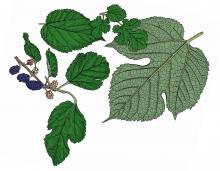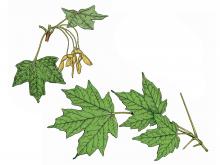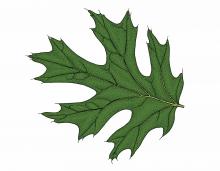Trees, Shrubs and Woody Vines
Media

Species Types
Scientific Name
Morus alba
Description
White mulberry was introduced from Asia for its berries and as fodder for an attempted silkworm industry. Birds have helped spread white mulberry so much that in many places it is more common than our native red mulberry.
Media

Species Types
Scientific Name
Platanus occidentalis
Description
The white, smooth-looking limbs of sycamore rise over countless streams and river banks, as well as over sidewalks and city streets. The leaves, which somewhat resemble those of maples, can reach remarkably large sizes.
Media

Species Types
Scientific Name
Acer rubrum
Description
Red maple is one of our most useful — and beautiful — native trees. You can find it in the woods as well as in landscape plantings statewide. Many horticultural varieties are available at nurseries.
Media

Species Types
Scientific Name
Acer saccharinum
Description
In nature, silver maple is a bottomland tree. Silver maples pay for their rapid growth by having rather brittle branches that easily break off in windy and other inclement weather.
Media

Species Types
Scientific Name
Acer saccharum
Description
Sugar maple is a tree that inspires much “oohing and aahing” during fall color season. Its sap is famous as a source for maple syrup, but its use in landscaping and for furniture is also widespread.
Media

Species Types
Scientific Name
Liriodendron tulipifera
Description
Though it only occurs naturally in the southeastern part of Missouri, the stately tulip tree is planted widely in lawns, parks, and cemeteries. The distinctive leaves and tulip-shaped flowers make it easy to identify.
Media

Species Types
Scientific Name
Acer negundo
Description
A member of the maple family, box elder is often confused with poison ivy because its compound leaves sometimes grow in threes (though also in fives). A fast-growing tree, its winged seeds betray its relationship to other maples.
Media

Species Types
Scientific Name
Lonicera japonica
Description
Don’t kid yourself about this invasive, exotic vine: Japanese honeysuckle is an aggressive colonizer that shades out native plants and harms natural communities. Learn how to recognize it!
Media

Species Types
Scientific Name
Rhus spp.
Description
Sumacs are shrubs or small trees that often form colonies from their creeping, branched roots. The foliage usually turns brilliant shades of red in early autumn. The clusters of berrylike fruits are red.
Media

Species Types
Scientific Name
Quercus velutina
Description
Black oak grows throughout Missouri, in upland woods, on glades, and along borders of woods and fields. It and scarlet oak were the primary colonizers of Ozark pinelands when the native pines were cleared in the early 1900s.
See Also
About Trees, Shrubs and Woody Vines in Missouri
There are no sharp dividing lines between trees, shrubs, and woody vines, or even between woody and nonwoody plants. “Wood” is a type of tissue made of cellulose and lignin that many plants develop as they mature — whether they are “woody” or not. Trees are woody plants over 13 feet tall with a single trunk. Shrubs are less than 13 feet tall, with multiple stems. Vines require support or else sprawl over the ground.





















